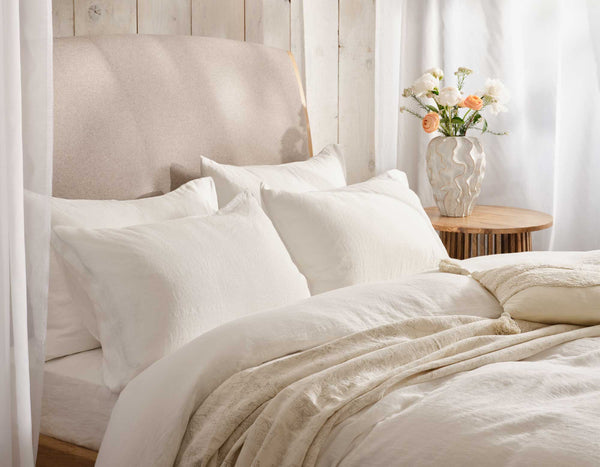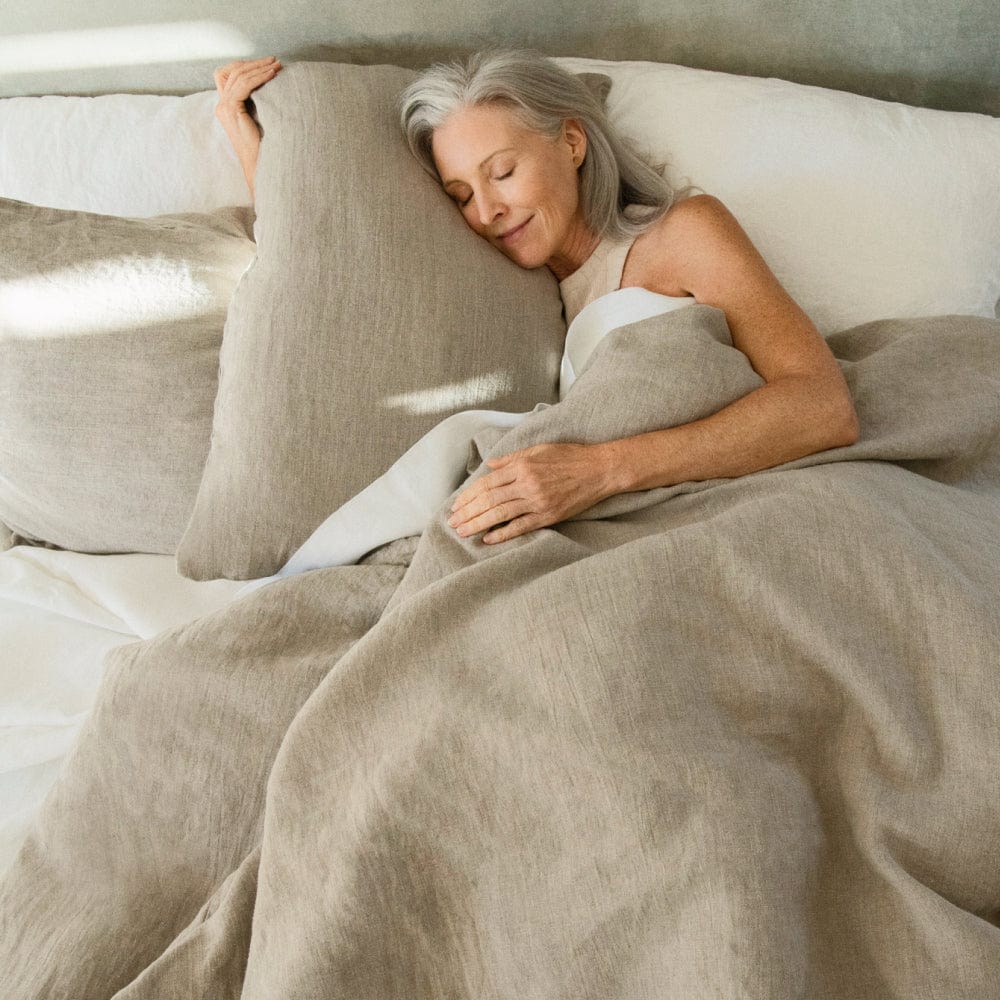Australia Linen vs Cotton: Which Is Better for Summer Wear?
Australia Linen vs Cotton: Which Is Better for Summer Wear?
Blog Article
Recognizing Linen: The Eco-Friendly Option for Comfy Living
When you believe regarding eco-friendly fabrics, bed linen typically stands out for its unique high qualities. What truly sets bed linen apart from various other materials? Let's check out the remarkable globe of bed linen even more.
The Origins of Linen: From Flax to Fabric

Linen, among the earliest textiles known to mankind, has a remarkable journey that begins with the simple flax plant. You might be amazed to discover that this plant flourishes in cool environments, thriving in areas like Europe and parts of Asia. Once harvested, the flax stalks go through a process called retting, where they're saturated to separate the fibers from the woody parts. After retting, the fibers are combed and spun right into thread, prepared for weaving.
When you see bed linen textile, you're observing centuries of craftsmanship. Linen has actually been treasured for its all-natural appearance and really feel, making it a favored for whatever from apparel to home textiles.
The Special Residence of Bed Linen
One of the standout features of this impressive fabric is its breathability. When you use linen, you'll observe how it permits air to circulate, maintaining you cool on warm days. This home makes it a best choice for summer season apparel and bedding.
Linen also boasts extraordinary moisture-wicking capabilities, drawing sweat away from your skin and enabling it to evaporate promptly. You won't really feel clammy, also in moist conditions. In addition, bed linen is resilient, commonly ending up being softer and much more comfortable with each clean, which indicates it can stand the examination of time in your closet.
An additional one-of-a-kind facet is its all-natural appearance; the mild abnormalities provide bed linen a personality that enhances your style. Plus, it withstands creases better than numerous various other textiles, so you can appreciate a relaxed yet brightened look without much initiative. Accept linen, and you'll value its convenience and special beauty.
Ecological Benefits of Linen
When you select linen, you're not just choosing a stunning textile; you're also supporting sustainable manufacturing methods. Linen's naturally degradable and compostable nature makes it a wise option for the atmosphere. Plus, it needs substantially much less water to create contrasted to various other textiles, assisting save this precious resource.
Lasting Manufacturing Practices
Although lots of fabrics have significant environmental impacts, bed linen stands out due to its sustainable production practices. When you pick linen, you're opting for a material made from the flax plant, which needs minimal water and chemicals.
Bed linen production is usually less energy-intensive contrasted to other textiles, as it entails all-natural procedures as opposed to artificial therapies. By supporting bed linen, you're adding to an extra sustainable textile sector that prioritizes eco-friendly methods. Choosing linen not just enhances your convenience but additionally aligns your values with ecological duty.
Compostable and eco-friendly Product
Linen's environment-friendly nature extends past its lasting production; it's compostable and likewise naturally degradable, making it an outstanding option for ecologically conscious customers. When you pick bed linen items, you're choosing for materials that break down naturally, returning nutrients to the planet. Composting bed linen can enhance soil, promoting healthy and balanced plant development.
Low Tide Intake
One of the standout advantages of bed linen is its low tide intake throughout growing. Unlike cotton, which needs considerable irrigation, bed linen's flax plant thrives on marginal water, making it a much more sustainable option. You'll appreciate understanding that for each lot of linen produced, considerably much less water is required contrasted to numerous various other textiles. This suggests that selecting linen assists conserve essential freshwater sources, which is crucial in today's environment. Furthermore, linen's natural drought resistance enables it to expand in less-than-ideal problems, further lowering its ecological effect. By choosing linen, you're not simply investing in top quality; you're likewise sustaining a fabric that promotes accountable water usage and adds to a healthier world for future generations.
Linen vs. Other Fabrics: A Contrast
When you compare linen to other materials, you'll observe its exceptional breathability and convenience, making it excellent for warm weather. Plus, linen attracts attention for its resilience and durability, commonly lasting longer than several commonly used products. As you consider your selections, the ecological influence of each material will certainly additionally play a vital function in your choice.
Breathability and Convenience
Breathability is a crucial consider choosing fabrics for comfort, especially in warm weather condition. Linen attracts attention amongst products for its impressive capacity to enable air flow. Unlike synthetic textiles, which can trap warm and dampness, bed linen's natural fibers wick away sweat, keeping you dry and cool. When you wear bed linen, you'll see just how it really feels light against your skin, enhancing your comfort throughout warm days.
Cotton is typically commended for its gentleness, yet it doesn't match linen's breathability. If you prioritize comfort, especially in summer season, bed linen ought to be your best option.
Longevity and Durability
While lots of textiles offer varying degrees of durability, linen really stands out in longevity, making it a wise investment for your closet. Unlike cotton or artificial products that might put on out promptly, bed linen obtains more powerful with each wash. You'll find that linen's breathable nature likewise lowers wear from sweat and dampness, which can harm various other materials.
Environmental Effect Contrast
Although several materials add to ecological issues, bed linen stands out for its environment-friendly high qualities. Unlike cotton, which requires huge water resources and chemicals, linen is made from flax, a plant that flourishes on very little water and needs less chemicals. This implies you can really feel great about your selection while minimizing your carbon footprint.
When contrasted to artificial materials like polyester, bed linen's biodegradability radiates. While polyester can take hundreds of years to break pop over to this site down, linen breaks down normally, returning nutrients to the soil.
Choosing bed linen not just promotes lasting farming practices yet also sustains a much healthier earth. By choosing bed linen over conventional textiles, you're making a mindful choice that benefits both your comfort and the setting.
Taking care of Your Linen Textiles
To ensure your linen fabrics continue to be in great condition, you'll desire to comply with some simple care standards. Wash your linen in chilly water on a gentle cycle to avoid it from shrinking or losing its form.
When it involves drying, air drying out is best. If you utilize a dryer, pick a reduced warmth setting and remove the items while they're still somewhat damp to decrease creases. Iron the bed linen while it's still damp for easier handling, or heavy steam it to keep it looking crisp.
For storage, keep your bed linen in a trendy, completely dry place. Stay clear of direct sunlight to stop fading. With these straightforward techniques, your bed linen fabrics will certainly keep their beauty and last for many years, making them a lasting enhancement to your way of living.
Including Bed Linen Into Your Home Décor
Looking after your bed linen fabrics not only preserves their high quality however also opens up a world of possibilities for integrating them into your home decoration. You can start small by adding linen toss pillows to your sofa, instantaneously boosting the room with structure and warmth. Consider bed linen drapes that filter sunlight wonderfully, creating a soft, airy atmosphere in any kind of area.
For a much more rustic look, attempt utilizing bed linen table linens or runners throughout dishes; they add a classy touch and are simple to clean. If you're really feeling adventurous, mix and suit different linen shades and patterns to produce a distinct, split impact.
Do not fail to remember about linen coverings-- curtain one over a chair or your bed for an inviting feeling. By attentively integrating bed linen into your decoration, you enhance both comfort and style, making your home a peaceful hideaway.
The Future of Linen in Lasting Living
As consumers increasingly focus on sustainability, linen arises as a frontrunner in environment-friendly fabrics. Its production utilizes much less water and pesticides compared to standard cotton, making it an extra environmentally responsible selection. As you look towards a sustainable future, incorporating linen right into your wardrobe and home can significantly lower your carbon footprint.
Ingenious brands are currently concentrating on sustainable techniques, from utilizing natural flax to executing round economic climate concepts. You'll locate that linen's durability indicates it lasts much longer, lowering the need for frequent replacements.
In addition, as more people embrace minimal lifestyles, bed linen's timeless appeal and flexibility will certainly maintain it pertinent. By choosing linen, you're not just going with convenience; you're likewise sustaining lasting techniques.
In the upcoming years, the demand for linen is expected to grow, solidifying its place in a more eco-conscious world. So, think about making bed linen a staple in your lasting living trip.
Frequently Asked Questions
Is Linen Suitable for Individuals With Allergic Reactions?
Yes, bed linen's natural fibers are hypoallergenic, making it suitable for individuals with allergic reactions. Its breathable nature assists minimize wetness and germs buildup, contributing to this contact form a healthier resting setting. You'll likely locate it comfy and risk-free.
Can Linen Be Colored Quickly?
Yes, you can dye linen easily. Its all-natural fibers soak up dyes well, enabling vivid shades. Simply make sure you utilize the best dye kind and comply with appropriate techniques to accomplish the desired outcomes without harming the fabric.
How Does Bed Linen Compare in Toughness to Cotton?

What Weight of Linen Is Best for Summer Clothes?
For summer clothes, lightweight linen around 4 to 5 ounces per yard is ideal. web It keeps you awesome, breathable, and comfortable in heat (Linen Australia). You'll value how it drapes and relocations with you effortlessly

Can Linen Be Used for Outdoor Furniture?
Yes, you can use linen for outside furniture. It's breathable and sturdy, making it a fantastic option for warm weather condition. Just make certain to choose a dealt with version to withstand the components and preserve its look.
Verdict
Including bed linen right into your life not just boosts your convenience yet additionally sustains an extra lasting future. By selecting this green textile, you're making a conscious decision that profits both your health and the earth. With its special properties and marginal ecological influence, linen is a smart choice for your home décor and lifestyle. Welcome bed linen, and take pleasure in the ideal blend of design, durability, and sustainability in your everyday living.
Linen's naturally degradable and compostable nature makes it a smart selection for the atmosphere. By integrating linen right into your home, you're not simply enjoying its comfort and resilience; you're also supporting environmentally friendly techniques and assisting produce a healthier earth. The Future of Linen in Lasting Living.

Report this page